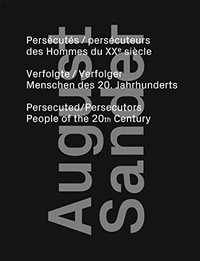August Sander
Verfolgte / Verfolger. Persécutés / Persécuteurs. Persecuted / Persecutors. People of the 20th Century
Menschen des 20. Jahrhunderts / Des hommes du XXe siecle. People of the 20th Century

Steidl Verlag, Göttingen 2018
ISBN 9783958295117
Gebunden, 240 Seiten, 30,00 EUR
ISBN 9783958295117
Gebunden, 240 Seiten, 30,00 EUR
Klappentext
Herausgegeben von Sophie Nagiscarde, Marie-Edith Agostini und Gerhard Sander. Recognized as one of the founding fathers of the documentary style, August Sander is the creator of many iconic twentieth-century photographs. Towards the end of the First World War, while working from his studio in Cologne, Sander began what would become his life's work: a photographic portrait of German society under the Weimar Republic. He called this endeavor People of the 20th Century. While his first publication was banned from sale in 1936 by the National Socialist government, in around 1938 Sander began taking identity photographs for persecuted Jews. During the Second World War he photographed migrant workers; Sander included these images, as well as some taken by his son Erich from the prison where he would die in 1944, in People of the 20th Century, along with portraits of national socialists made before and during the war. Sander was unable to publish his monumental work during his lifetime, but his descendants champion his vision to this day.
These photographs are published together for the first time here, along with contact prints, letters and details about the lives of those photographed. They are portraits of dignified men and women, victims of an ideology taking their rightful place as "People of the 20th Century" in defiance of Nazi efforts to ostracize them.
Rezensionsnotiz zu Die Tageszeitung, 20.02.2019
Ohne wertende Attribute, aber offenbar beeindruckt annonciert Jochen Becker diesen Band, den man sich als postnationalsozialistische Fortschreibung von August Sanders Großwerk "Menschen des 20. Jahrhunderts" vorstellen kann. So weit sich Beckers etwas erratischer Darstellung entnehmen lässt, hat die August-Sander-Stiftung zusammen mit dem NS-Dokumentationszentrum für diesen Band Porträts von Nazis und Juden, von Verfolgern und Verfolgten zusammengestellt und dafür auch die Biografien der Porträtierten rekonstruiert. Viele Fotos hat offenbar auch Sanders Sohn Erich beigetragen. Der Rezensent weiß, dass die hier abgebildeten Kölner Juden die Aufnahmen nicht freiwillig machen ließen, sondern Fotos brauchten, um sich sich mit Kennkarten erfassen zu lassen, lässt einen aber mit dieser Information ein wenig allein.
Themengebiete
Kommentieren







